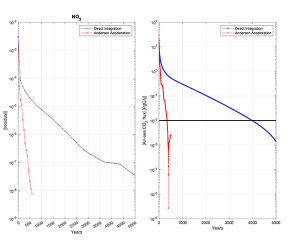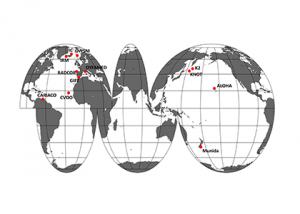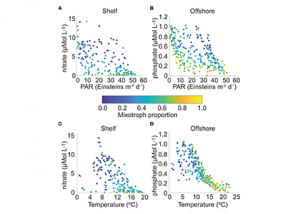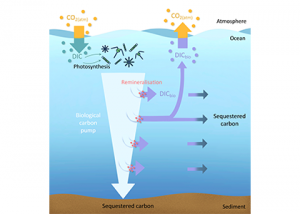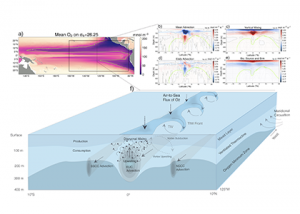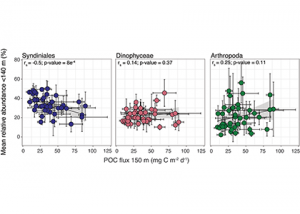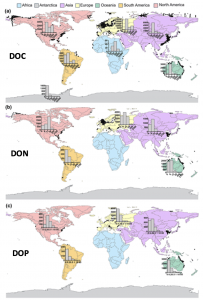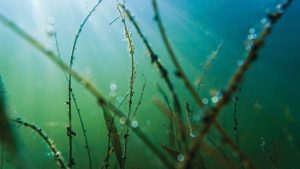If you would like to have your recent publications featured on the OCB website please contact ocb_news@whoi.edu. View our guidelines for writing a New OCB Research post.
New algorithm unclogs major bottleneck in ocean geochemical and biogeochemical modelling
Numerical models are some of the principal tools for understanding the cycling of geochemical and biogeochemical tracers in the ocean, with the latter also being important components of the Earth System Models used to project future climate change. However, in order to use these models they must first be integrated to a seasonally-repeating equilibrium with […]
Read MoreWhether we aim to disentangle anthropogenic driven trends from naturally variability or we want to assess and improve our ocean model’s capabilities to correctly display changes in time, all require high-quality observational data from multiple fixed time-series data. Until now access to these data was difficult, time-consuming, and often required solving multiple data challenges before […]
Read MoreMixotrophs in the northern North Atlantic
Mixotrophs (or mixoplankton) are now accepted as a third group of plankton alongside phytoplankton and zooplankton. Our knowledge of mixotrophs lags far behind that of the other two groups. We currently have only a limited understanding of mixotrophs’ biogeographical distribution across ocean basins, and what environmental factors are associated with their distribution. The authors of […]
Read MoreThe biological carbon pump plays a key role in ocean carbon sequestration by transporting organic carbon from the upper ocean to deeper waters via three broad processes: the sinking of organic particles, vertical migration of organisms, and physical mixing. Most studies assume that century-scale carbon sequestration occurs only in the deep ocean, thus have missed […]
Read MoreWhat balances oxygen removal in the equatorial Pacific? For a long time, oxygen in the eastern and central tropical Pacific was assumed to be mainly supplied by the large-scale advection of remotely ventilated waters via the equatorial current system and meridional circulation. A recent study used an eddy-resolving simulation of a global ocean model to […]
Read MoreTiny parasites, big impact: Species networks and carbon recycling in an oligotrophic ocean
Parasites are everywhere in the ocean. Including the microbial realm where a diverse, widespread group of protist parasites (Syndiniales) infect and kill a range of hosts, such as dinoflagellates, radiolarians, and even larger zooplankton. A complete Syndiniales infection cycle is only 2-3 days. First, the parasite is a free-living spore. Once inside a host, the […]
Read MoreCoastal DOM database – CoastDOM v1
We present the first edition of a global database (CoastDOM v1) and a resulting data manuscript, which compiles previously published and unpublished measurements of DOC, DON, and DOP in coastal waters, consisting of 62,338 (DOC), 20,356 (DON), and 13,533 (DOP) data points, respectively. CoastDOM v1 includes observations of concentrations from all continents between 1978 and […]
Read MoreTwo OCB-led articles featured in AGU Eos Feb. Oceans Issue
A Closer Look-Sea at the Ocean’s Carbon Cycle AGU Eos highlights the following two articles emerging from OCB-led activities, including the OCB 2022 plenary session on the biological carbon pump and the 2022 OCB Workshop Marine Carbon Dioxide Removal: Essential Science and Problem Solving for Measurement, Reporting, and Verification. Our Evolving Understanding of Biological Carbon […]
Read MoreNew synthesis of global ocean greenhouse gas fluxes
Resplandy, L., Hogikyan, A., Müller, J. D., Najjar, R. G., Bange, H. W., Bianchi, D., et al. (2024). A synthesis of global coastal ocean greenhouse gas fluxes. Global Biogeochemical Cycles, 38, e2023GB007803. https://doi.org/10.1029/2023GB007803.
Read MoreNew framework reveals gaps in US ocean biodiversity protection
Gignoux-Wolfsohn et al., New framework reveals gaps in US ocean biodiversity protection, OneEarth (2023), https:// doi.org/10.1016/j.oneear.2023.12.014. (accompanying fact sheet)
Read More
